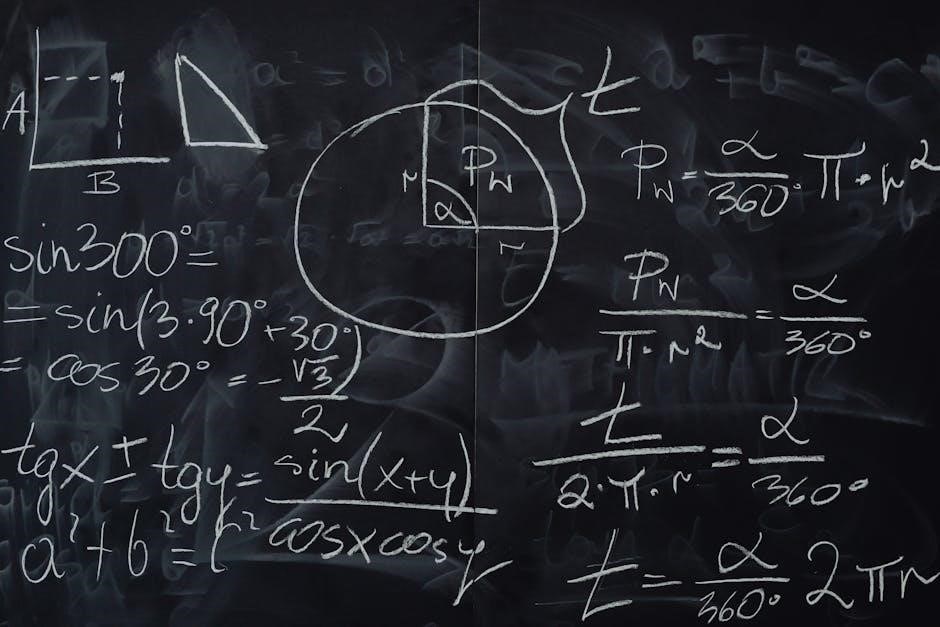Triangle Similarity: An Overview
Two triangles are similar if all three pairs of their corresponding sides are in the same ratio. This section explores identifying and using similar triangles. Worksheets help practice problems based on Side-Side-Side (SSS)

Criteria for Triangle Similarity
To determine if triangles are similar, we use specific criteria. These include Angle-Angle (AA), Side-Angle-Side (SAS), and Side-Side-Side (SSS) similarity. Worksheets provide practice in applying these theorems to identify similar triangles and complete similarity statements.
Angle-Angle (AA) Similarity
The Angle-Angle (AA) Similarity postulate states that if two angles of one triangle are congruent to two angles of another triangle, then the two triangles are similar. This is one of the easiest ways to prove triangle similarity, as you only need to show that two corresponding angles are equal in measure. Worksheets often provide diagrams with angle measures indicated, requiring students to identify whether the AA Similarity postulate applies.
For example, if triangle ABC has angles measuring 60 degrees and 80 degrees, and triangle XYZ also has angles measuring 60 degrees and 80 degrees, then triangle ABC is similar to triangle XYZ by AA Similarity. It’s important to remember that the third angle in each triangle will also be congruent due to the Triangle Sum Theorem (the sum of angles in a triangle is always 180 degrees).
AA Similarity worksheets may include problems where students need to calculate missing angle measures to determine if the triangles are similar. These worksheets often require students to write similarity statements, such as ΔABC ~ ΔXYZ, indicating which triangles are similar and the order of corresponding vertices.
Furthermore, some AA Similarity problems might be embedded within more complex geometric figures, requiring students to first identify the triangles they need to analyze and then apply the AA Similarity postulate. Understanding the AA Similarity postulate is crucial for solving various geometry problems and proving relationships between triangles. These worksheets are designed to reinforce this concept through practice and application.
In summary, AA Similarity is a powerful tool for proving that two triangles are similar based solely on their angle measures. By mastering this concept, students can solve a wide range of geometry problems involving similar triangles. The worksheets provide ample opportunity to practice identifying and applying the AA Similarity postulate in various scenarios.
Side-Angle-Side (SAS) Similarity
The Side-Angle-Side (SAS) Similarity theorem states that if two sides of one triangle are proportional to two corresponding sides of another triangle, and the included angles (the angles between those sides) are congruent, then the two triangles are similar. This theorem combines both side proportionality and angle congruence to establish similarity. SAS Similarity worksheets typically present problems where students need to determine if the ratios of two pairs of sides are equal and if the angle between those sides is congruent.
For example, consider triangle PQR and triangle STU. If PQ/ST = PR/SU and angle P is congruent to angle S, then triangle PQR is similar to triangle STU by SAS Similarity. It’s crucial to correctly identify the corresponding sides and the included angle. Worksheets will often provide side lengths and angle measures, challenging students to calculate the ratios and compare the angles.
SAS Similarity problems might also involve algebraic expressions for side lengths, requiring students to set up proportions and solve for unknown variables. This adds an extra layer of complexity, combining geometry with algebra skills. Students must carefully analyze the given information, set up the correct proportions, and use algebraic techniques to find the missing values.
Furthermore, some worksheets may include diagrams where triangles overlap or share sides, making it necessary to identify the relevant sides and angles for each triangle separately. These types of problems test students’ ability to visualize and extract information from complex geometric figures.
Understanding SAS Similarity is essential for solving a variety of geometry problems related to similar triangles. The worksheets provide numerous opportunities to practice applying the theorem in different contexts, reinforcing the concept and improving problem-solving skills. By working through these exercises, students will gain confidence in identifying and proving triangle similarity using the SAS criterion.
In summary, mastering SAS Similarity involves recognizing proportional sides and congruent included angles. The worksheets offer a structured approach to practicing this theorem, enabling students to develop a strong foundation in geometric reasoning and problem-solving.
Side-Side-Side (SSS) Similarity
The Side-Side-Side (SSS) Similarity Theorem is a fundamental concept in geometry that allows us to determine if two triangles are similar based solely on the lengths of their sides. According to this theorem, if all three pairs of corresponding sides of two triangles are proportional, then the two triangles are similar. This means that the ratios of the lengths of the corresponding sides must be equal. SSS Similarity worksheets provide students with exercises to practice identifying and proving similarity using this criterion.
To apply the SSS Similarity Theorem, you need to compare the ratios of the corresponding sides of the two triangles. If the ratios are equal, then the triangles are similar. For example, consider two triangles, ABC and DEF, where AB corresponds to DE, BC corresponds to EF, and CA corresponds to FD. If AB/DE = BC/EF = CA/FD, then triangle ABC is similar to triangle DEF.
SSS Similarity worksheets often include problems where students are given the side lengths of two triangles and are asked to determine if the triangles are similar. These problems require students to calculate the ratios of the corresponding sides and compare them. If the ratios are all equal, then the triangles are similar, and students may be asked to write a similarity statement, such as ΔABC ~ ΔDEF.
In some cases, the worksheets may present more challenging problems where the side lengths are given as algebraic expressions. Students will need to set up proportions and solve for unknown variables to determine if the ratios are equal. These types of problems combine geometric concepts with algebraic skills, providing a more comprehensive practice.
Moreover, SSS Similarity worksheets may also include diagrams where the triangles are overlapping or sharing sides, requiring students to carefully identify the corresponding sides and calculate their ratios accurately. These problems test students’ ability to visualize and analyze geometric figures.
Understanding the SSS Similarity Theorem is crucial for solving various geometry problems involving similar triangles. These worksheets offer ample opportunities to practice applying the theorem in different contexts, reinforcing the concept and enhancing problem-solving skills. By working through these exercises, students can develop a strong understanding of SSS Similarity and its applications.
In summary, mastering SSS Similarity involves comparing the ratios of corresponding sides of two triangles. If all three ratios are equal, the triangles are similar. The worksheets provide a structured approach to practicing this theorem, enabling students to build a solid foundation in geometric reasoning.
Solving for Missing Sides in Similar Triangles
Solving for missing sides in similar triangles is a common application of triangle similarity principles. When two triangles are known to be similar, their corresponding sides are proportional. This proportionality allows us to set up ratios and solve for unknown side lengths; Worksheets focused on this topic provide students with practice in identifying corresponding sides, setting up proportions, and using algebraic techniques to find the missing values.
The first step in solving for missing sides is to correctly identify the corresponding sides of the two similar triangles. Corresponding sides are those that occupy the same relative position in each triangle. Once the corresponding sides are identified, a proportion can be set up. A proportion is an equation stating that two ratios are equal. For example, if triangle ABC is similar to triangle DEF, and we want to find the length of side DE, we can set up the proportion AB/DE = BC/EF.
After setting up the proportion, the next step is to substitute the known side lengths into the equation. If AB = 6, BC = 8, EF = 4, and we want to find DE, the proportion becomes 6/DE = 8/4. To solve for DE, we can cross-multiply: 6 * 4 = 8 * DE, which simplifies to 24 = 8 * DE. Dividing both sides by 8, we find that DE = 3.
Worksheets often include diagrams of the triangles with the known side lengths labeled. These diagrams help students visualize the problem and identify the corresponding sides more easily. Some problems may involve more complex algebraic expressions, requiring students to apply their knowledge of solving equations.
In some cases, the triangles may be overlapping or sharing sides, which can make it more challenging to identify the corresponding sides. Students need to carefully analyze the diagram and use the given information to determine the correct proportions. These types of problems encourage critical thinking and problem-solving skills.
The worksheets may also include problems where students need to find multiple missing side lengths. In these cases, they can set up multiple proportions using the same pair of similar triangles. By solving these proportions, they can find all the missing side lengths.
Practicing with these worksheets helps students develop a strong understanding of how to use triangle similarity to solve for missing sides. It reinforces their algebraic skills and their ability to apply geometric principles to real-world problems. By working through a variety of problems, students can build confidence in their ability to solve for missing sides in similar triangles.

Writing Similarity Statements
Writing similarity statements is a crucial skill in geometry, particularly when dealing with similar triangles. A similarity statement is a concise way to express the correspondence between the vertices of two similar triangles. The order of the vertices in the statement is critical because it indicates which angles and sides correspond.
When writing a similarity statement, it’s essential to ensure that the corresponding angles are in the same position in both triangles. For example, if triangle ABC is similar to triangle DEF, and angle A corresponds to angle D, angle B corresponds to angle E, and angle C corresponds to angle F, then the correct similarity statement is ΔABC ~ ΔDEF. The symbol “~” indicates similarity.
If the order of the vertices is incorrect, the similarity statement will be misleading. For instance, ΔABC ~ ΔFED would imply that angle A corresponds to angle F, which is not the case in our example. Therefore, careful attention must be paid to the correspondence of angles.
Worksheets focusing on writing similarity statements typically provide pairs of similar triangles with given angle measures or side lengths. Students are required to analyze the triangles and determine the correct correspondence between the vertices. This involves identifying which angles are congruent and which sides are proportional.
Some worksheets may include diagrams where the triangles are rotated or reflected, making it more challenging to identify the corresponding vertices. In these cases, students need to carefully examine the angle measures or side lengths to determine the correct order.
In addition to writing similarity statements, worksheets may also ask students to explain why the triangles are similar. This requires them to apply the similarity postulates, such as Angle-Angle (AA), Side-Angle-Side (SAS), or Side-Side-Side (SSS). They need to provide evidence to support their claim that the triangles are similar.
By practicing with these worksheets, students develop a deeper understanding of the concept of similarity and the importance of accurate notation. They learn to analyze geometric figures, identify corresponding parts, and express their findings in a clear and concise manner. This skill is essential for solving more complex geometry problems and for communicating mathematical ideas effectively.

Applications of Similar Triangles
Similar triangles are not just theoretical concepts confined to geometry textbooks; they have a wide range of practical applications in various fields. Understanding and applying the principles of similar triangles can help solve real-world problems in surveying, architecture, engineering, and even everyday life.
One of the most common applications is in surveying. Surveyors use similar triangles to determine distances and heights that are difficult or impossible to measure directly. For example, they can use a technique called triangulation, which involves creating a network of triangles and measuring the angles and sides of some of the triangles. By applying the properties of similar triangles, they can calculate the lengths of the other sides and determine the distances between different points.
In architecture and engineering, similar triangles are used to create scale models of buildings and structures. Architects and engineers use these models to visualize the design and identify potential problems before construction begins. The models are created using the same proportions as the actual building, ensuring that all the dimensions are accurate.
Another application is in determining the height of tall objects, such as trees or buildings. By measuring the length of the shadow cast by the object and comparing it to the length of the shadow cast by an object of known height, one can use similar triangles to calculate the height of the taller object. This method is based on the principle that the angles of elevation of the sun are the same for both objects at the same time.
Similar triangles are also used in navigation to determine distances and directions. For example, sailors use sextants to measure the angle between the horizon and a celestial body, such as the sun or a star. By using this angle and the time of day, they can determine their latitude. They can then use similar triangles to calculate the distance to a known landmark or another ship.
Worksheets focusing on the applications of similar triangles often present students with real-world scenarios and ask them to solve problems using the principles of similarity. These problems may involve finding the height of a tree, determining the distance across a river, or calculating the dimensions of a scale model. By working through these problems, students gain a deeper appreciation for the practical value of similar triangles and develop their problem-solving skills.
Worksheet Practice Problems and Examples

Similar Right Triangles
Similar right triangles possess unique properties that make them particularly useful in various geometric and trigonometric applications. When an altitude is drawn from the right angle of a right triangle to its hypotenuse, it creates two smaller right triangles that are each similar to the original triangle and to each other. This principle forms the basis for solving many problems involving right triangles.
The similarity of these triangles allows us to set up proportions involving their corresponding sides. These proportions can then be used to find missing side lengths or to prove geometric relationships. For example, if we know the lengths of some of the sides in the original triangle and one of the smaller triangles, we can use the similarity to find the lengths of the remaining sides.
A common type of problem involves finding the geometric mean (also known as the mean proportional) between two segments of the hypotenuse. The altitude drawn to the hypotenuse is the geometric mean between the two segments of the hypotenuse. This relationship can be expressed as: altitude² = (segment 1) * (segment 2).
Another important relationship arises when considering each leg of the original right triangle. Each leg is the geometric mean between the entire hypotenuse and the segment of the hypotenuse adjacent to that leg. This can be expressed as: leg² = (adjacent hypotenuse segment) * (whole hypotenuse).
Worksheets on similar right triangles often include problems that require students to apply these relationships to find missing side lengths. They might be given a right triangle with the altitude drawn to the hypotenuse and asked to find the length of the altitude or one of the segments of the hypotenuse. Other problems might involve finding the lengths of the legs of the original triangle, given the lengths of the hypotenuse and one of its segments.
These types of problems reinforce the concept of similarity and help students develop their problem-solving skills in geometry. Understanding similar right triangles is also essential for understanding trigonometric ratios, such as sine, cosine, and tangent, which are defined in terms of the ratios of the sides of a right triangle. By mastering the concepts of similar right triangles, students build a solid foundation for further study in mathematics and related fields.
